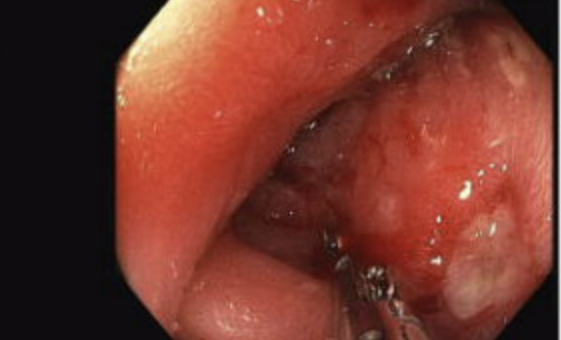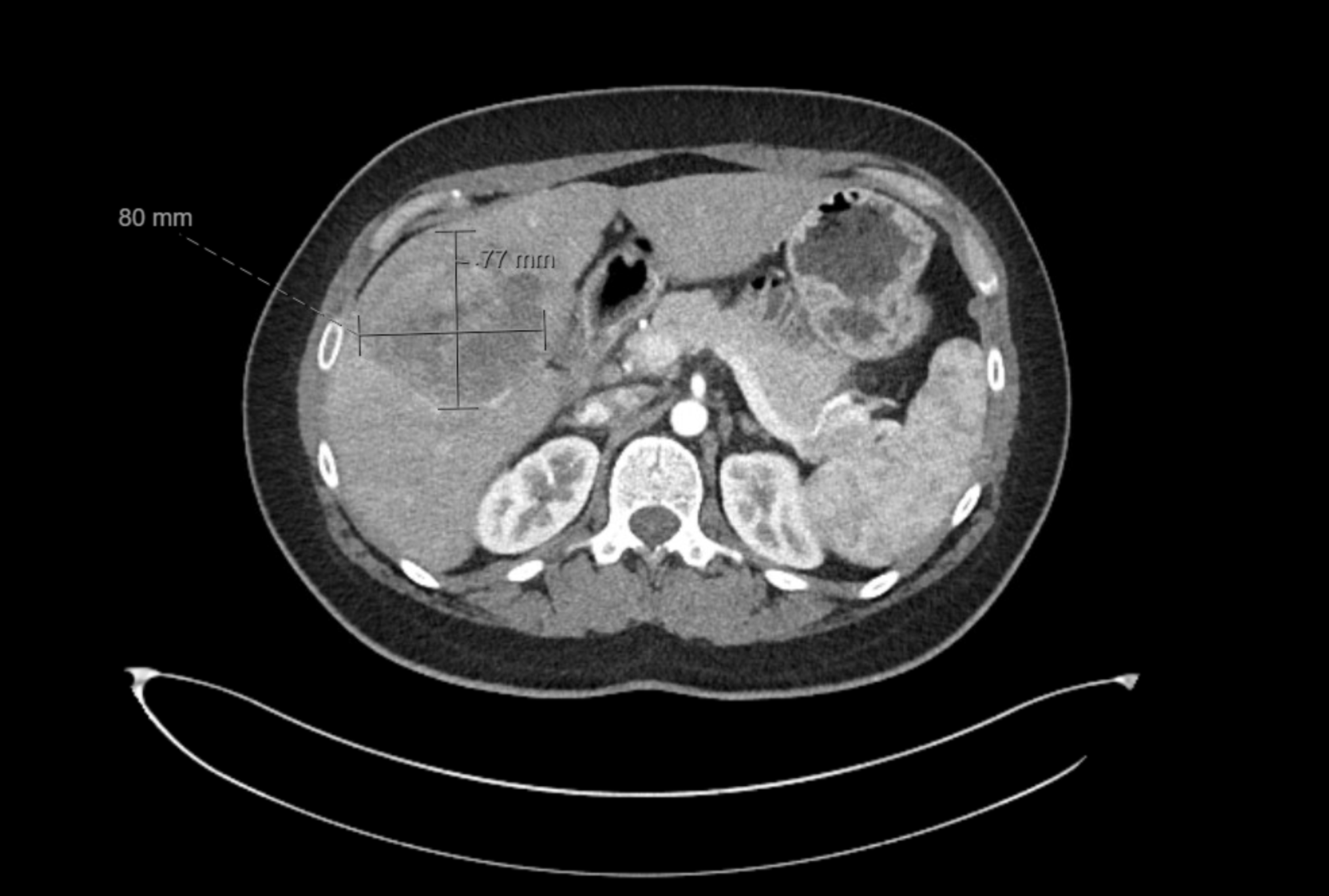Sunday Poster Session
Category: Liver
P1828 - When the Liver Lies: A Rare Presentation of Primary Hepatic Gastrinoma
Sunday, October 26, 2025
3:30 PM - 7:00 PM PDT
Location: Exhibit Hall

Guneet Sidhu, MD
University of North Dakota, School of Medicine and Health Sciences
Fargo, ND
Presenting Author(s)
Guneet Sidhu, MD1, Ross Meidinger, MD2
1University of North Dakota, School of Medicine and Health Sciences, Fargo, ND; 2Sanford Health, Fargo, ND
Introduction: Zollinger-Ellison Syndrome (ZES) is caused by gastrin-secreting neuroendocrine tumors most commonly originating in the pancreas or duodenum. The liver is a frequent site of metastasis, but primary hepatic gastrinomas are exceedingly rare, with fewer than 30 cases reported. Distinguishing primary hepatic gastrinoma from metastatic disease is critical, as complete surgical resection can be curative.
Case Description/
Methods: 34Y F with no significant past medical history presented with RUQ abdominal pain that began the night prior. Pain did not radiate to the shoulders or back and had no clear food-related triggers. She denied fever, chills, constipation, diarrhea, or any history of abdominal surgeries. Abd U/S showed a 9.8 x 6.5 cm solid lesion in the right hepatic lobe. CT showed a heterogeneously enhancing mass in the same region, concerning a malignant neoplasm. A liver biopsy confirmed a well-differentiated neuroendocrine tumor, WHO grade 2. Subsequent workup, including EGD, EUS, and FNA biopsies, showed no evidence of a primary lesion in the GI tract. Gastrin levels were elevated over 700 pg/mL. Enteroscopy demonstrated scattered erosions throughout the duodenum and proximal jejunum, along with deeper ulcerations and edema in the third part of the duodenum, consistent with ZES. EUS failed to identify a primary tumor, and FNA of peripancreatic lymph nodes was benign. To prepare for surgical resection, the patient underwent right portal vein embolization to promote hypertrophy of the left liver. She then underwent a robotic right hepatectomy to remove the hepatic neuroendocrine tumor. Two months postoperatively, repeat enteroscopy showed healed duodenal ulcers with mild, non-obstructive luminal narrowing and mucosal scarring in the third portion of the duodenum. No active inflammation was observed, and her gastrin levels had normalized. This case represents an extremely rare instance of a primary hepatic neuroendocrine tumor.
Discussion: This case highlights an extremely rare presentation of primary hepatic gastrinoma resulting in Zollinger-Ellison syndrome. The absence of an extrahepatic primary tumor despite extensive imaging and endoscopic evaluation, combined with postoperative normalization of gastrin levels and symptom resolution, supports the liver lesion as the primary source. This case emphasizes the importance of a comprehensive diagnostic approach and suggests that, when confirmed, surgical resection can be curative in primary hepatic gastrinoma.

Figure: Ulceration and edema in the 3rd portion of the duodenum

Figure: Ulceration and edema in the 3rd portion of the duodenum
Disclosures:
Guneet Sidhu indicated no relevant financial relationships.
Ross Meidinger indicated no relevant financial relationships.
Guneet Sidhu, MD1, Ross Meidinger, MD2. P1828 - When the Liver Lies: A Rare Presentation of Primary Hepatic Gastrinoma, ACG 2025 Annual Scientific Meeting Abstracts. Phoenix, AZ: American College of Gastroenterology.
1University of North Dakota, School of Medicine and Health Sciences, Fargo, ND; 2Sanford Health, Fargo, ND
Introduction: Zollinger-Ellison Syndrome (ZES) is caused by gastrin-secreting neuroendocrine tumors most commonly originating in the pancreas or duodenum. The liver is a frequent site of metastasis, but primary hepatic gastrinomas are exceedingly rare, with fewer than 30 cases reported. Distinguishing primary hepatic gastrinoma from metastatic disease is critical, as complete surgical resection can be curative.
Case Description/
Methods: 34Y F with no significant past medical history presented with RUQ abdominal pain that began the night prior. Pain did not radiate to the shoulders or back and had no clear food-related triggers. She denied fever, chills, constipation, diarrhea, or any history of abdominal surgeries. Abd U/S showed a 9.8 x 6.5 cm solid lesion in the right hepatic lobe. CT showed a heterogeneously enhancing mass in the same region, concerning a malignant neoplasm. A liver biopsy confirmed a well-differentiated neuroendocrine tumor, WHO grade 2. Subsequent workup, including EGD, EUS, and FNA biopsies, showed no evidence of a primary lesion in the GI tract. Gastrin levels were elevated over 700 pg/mL. Enteroscopy demonstrated scattered erosions throughout the duodenum and proximal jejunum, along with deeper ulcerations and edema in the third part of the duodenum, consistent with ZES. EUS failed to identify a primary tumor, and FNA of peripancreatic lymph nodes was benign. To prepare for surgical resection, the patient underwent right portal vein embolization to promote hypertrophy of the left liver. She then underwent a robotic right hepatectomy to remove the hepatic neuroendocrine tumor. Two months postoperatively, repeat enteroscopy showed healed duodenal ulcers with mild, non-obstructive luminal narrowing and mucosal scarring in the third portion of the duodenum. No active inflammation was observed, and her gastrin levels had normalized. This case represents an extremely rare instance of a primary hepatic neuroendocrine tumor.
Discussion: This case highlights an extremely rare presentation of primary hepatic gastrinoma resulting in Zollinger-Ellison syndrome. The absence of an extrahepatic primary tumor despite extensive imaging and endoscopic evaluation, combined with postoperative normalization of gastrin levels and symptom resolution, supports the liver lesion as the primary source. This case emphasizes the importance of a comprehensive diagnostic approach and suggests that, when confirmed, surgical resection can be curative in primary hepatic gastrinoma.

Figure: Ulceration and edema in the 3rd portion of the duodenum

Figure: Ulceration and edema in the 3rd portion of the duodenum
Disclosures:
Guneet Sidhu indicated no relevant financial relationships.
Ross Meidinger indicated no relevant financial relationships.
Guneet Sidhu, MD1, Ross Meidinger, MD2. P1828 - When the Liver Lies: A Rare Presentation of Primary Hepatic Gastrinoma, ACG 2025 Annual Scientific Meeting Abstracts. Phoenix, AZ: American College of Gastroenterology.
